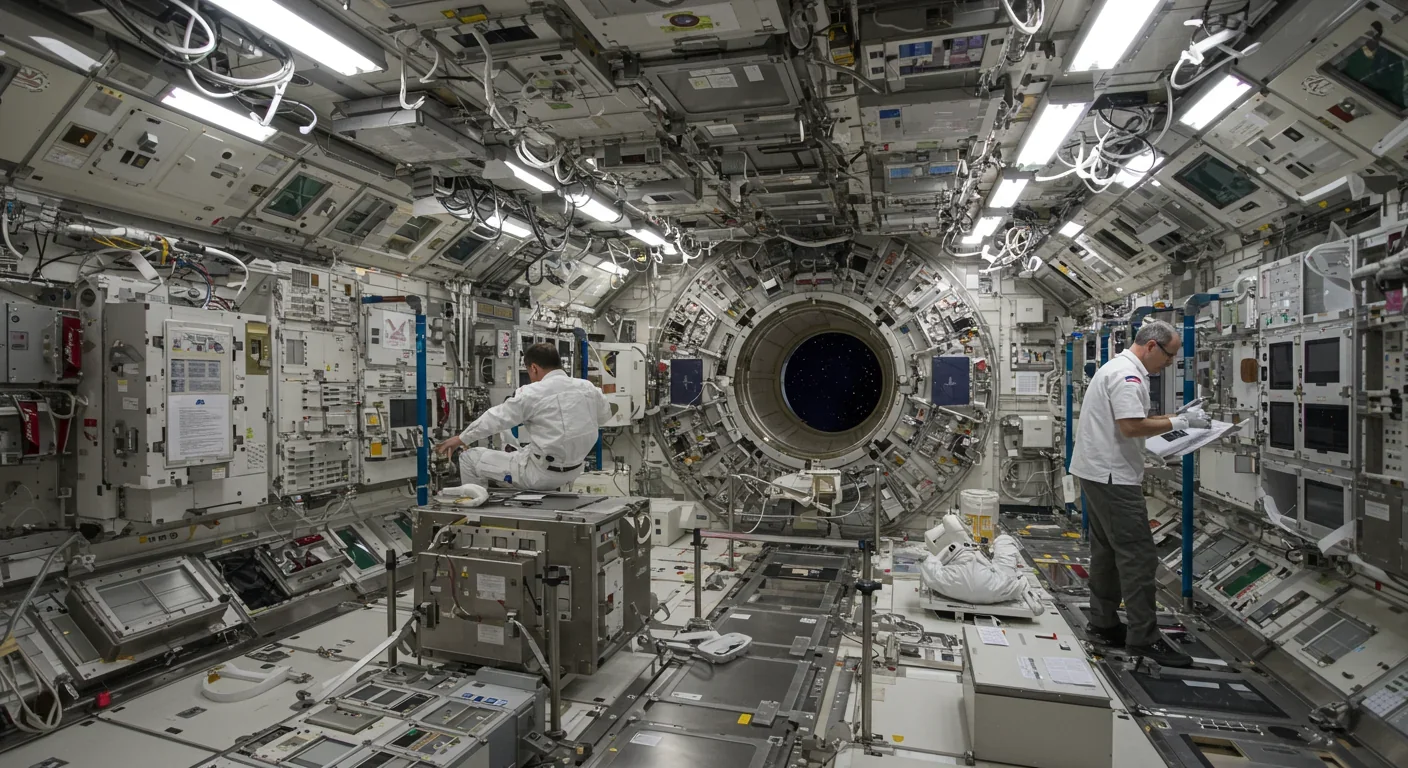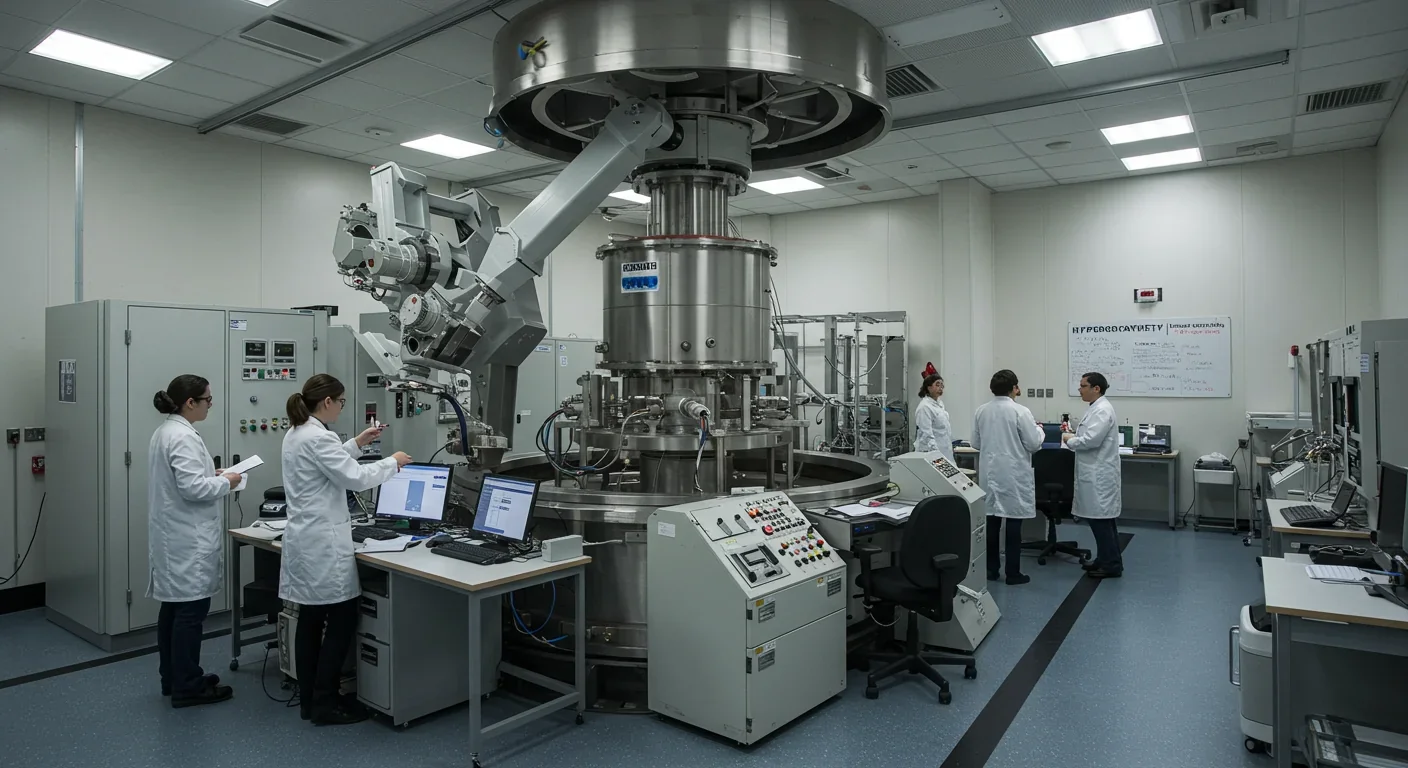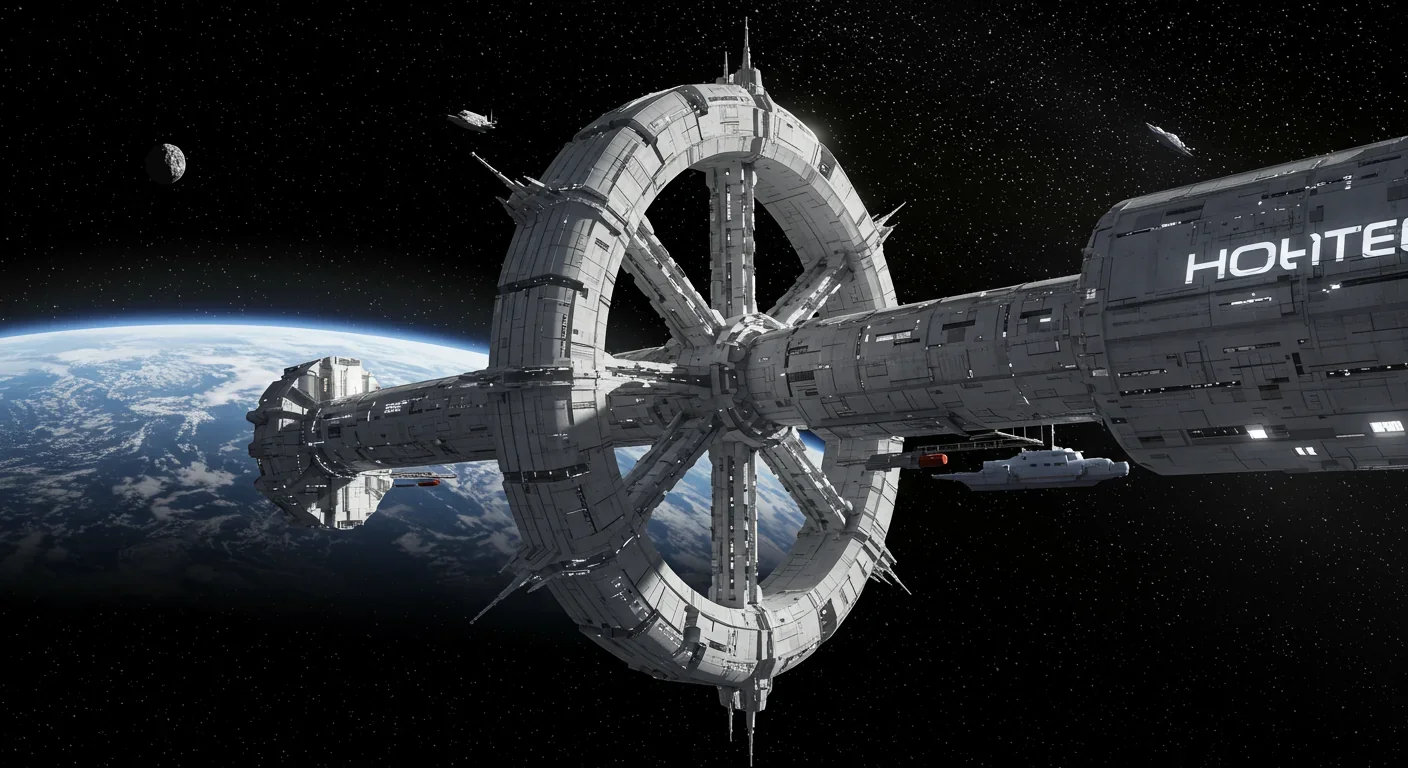Fusion Rockets Could Reach 10% Light Speed: The Breakthrough

TL;DR: Artificial gravity is transitioning from science fiction to practical engineering reality, with rotating habitats and centrifuge research advancing rapidly to solve the devastating health effects of long-term spaceflight on human physiology.

Within the next two decades, astronauts traveling to Mars won't be floating around their cabin in zero gravity. Instead, they'll walk through corridors and sit at tables that feel remarkably like home. The technology that science fiction promised for generations is finally crossing from fantasy into engineering reality, and the transformation is happening faster than most people realize.
Artificial gravity isn't really gravity at all. It's acceleration masquerading as gravitational pull, and it comes in two main flavors: rotation and linear thrust. The rotating habitat concept relies on centrifugal force, spinning a structure fast enough that occupants feel pressed against the outer wall. The math is elegantly simple: the faster you spin, or the bigger the radius, the stronger the simulated gravity.
Linear acceleration offers a different approach. Push a spacecraft forward continuously, and everyone inside experiences that acceleration as weight. This is exactly how rocket launches pin astronauts to their seats, only sustained indefinitely. The challenge? Maintaining constant thrust requires enormous amounts of fuel or revolutionary propulsion systems we're only beginning to develop.
Both approaches face the same fundamental constraint: they're expensive. Spinning requires structural engineering capable of withstanding tremendous rotational forces. Continuous acceleration demands energy sources that dwarf anything we've deployed in space. Yet researchers are convinced these obstacles are surmountable because the alternative, sending humans on multi-year missions through weightlessness, carries devastating costs.
Arthur C. Clarke wrote about geostationary satellites in 1945, and by 1963 NASA had Syncom 2 orbiting exactly where he predicted. Science fiction has always operated as humanity's unauthorized research and development department. The rotating space stations of 2001: A Space Odyssey and The Expanse weren't just entertainment, they were thought experiments that identified problems and proposed solutions decades before anyone had funding to attempt them.
Gerard K. O'Neill's cylindrical habitats, proposed in the 1970s, captured imaginations precisely because they solved real engineering puzzles. His designs showed how rotation could generate gravity, how mirrors could channel sunlight, how radiation shielding might actually work. NASA commissioned artists to visualize these concepts, and those paintings featuring farmland curving overhead became cultural touchstones that still inform how we imagine space colonization.
The Bishop Ring concept, introduced by Forrest Bishop in 1997, stretched these ideas to absurd scales: a ring-shaped habitat 1,000 kilometers in diameter, wide enough to host billions of people. It sounds preposterous until you realize the physics work perfectly. The only question is whether we can manufacture materials strong enough to build it.
These fictional frameworks matter because they provide engineers with targets. When you can visualize what success looks like, the pathway from concept to prototype becomes clearer. Fiction creates permission to take risks, to propose ideas that sound crazy until someone calculates the numbers and discovers they're merely difficult.
China's CHIEF1300 centrifuge just demonstrated 300 times Earth's gravity, with a 21-foot arm capable of carrying 20 metric tons. That's not a space station, it's a ground-based research facility designed to simulate extreme gravitational environments. The next-generation centrifuges will reach 1,500Gs, creating test beds for spacecraft components that must withstand the stresses of rotation-based artificial gravity.
Meanwhile, Germany's :envihab facility runs bedrest studies that simulate microgravity by having volunteers lie in a six-degree head-down tilt for 30 to 60 days. But some volunteers spend time in :envihab's human centrifuge during their bedrest period, testing whether short bursts of artificial gravity can counteract the damage. Early results suggest that just 30 minutes of daily centrifuge exposure preserves bone mass and cardiovascular function far better than exercise alone.
NASA's Zero Gravity Research Facility operates at the opposite end, providing 5.2 seconds of freefall inside a 432-foot vacuum chamber. It's where engineers test equipment behavior in microgravity without the expense of launching into orbit. That institutional knowledge informs every decision about artificial gravity systems: you can't design effective countermeasures until you understand exactly what you're counteracting.
Orbital Assembly Corporation has moved beyond ground-based analogs to propose actual rotating space stations. Their Voyager Station design features a ring 200 meters in diameter, spinning to generate lunar or Martian gravity levels. The fact that serious aerospace engineers are drafting these plans marks a shift from theoretical discussion to practical engineering.

Every tissue in your body evolved under Earth's 1G pull. Remove that constant force, and biological systems start breaking down. Astronauts lose 1-2% of bone mass per month in space, their hearts atrophy, their immune systems weaken, their vision deteriorates from fluid pressure on the optic nerve. Space doesn't just make you weak, it fundamentally reshapes your physiology.
The cardiovascular changes are particularly concerning. Hearts in microgravity don't work as hard, so they shrink and lose efficiency. When astronauts return after six months on the International Space Station, they often can't stand without fainting. Some require months of reconditioning to walk normally again. Imagine arriving at Mars after a nine-month journey and needing to immediately start complex tasks. That's not a minor inconvenience, it's a mission failure scenario.
Muscle atrophy progresses relentlessly despite aggressive exercise protocols. ISS crews work out two hours daily, using resistance bands and specialized equipment. They slow the degradation but can't stop it entirely. Surgeons performing delicate procedures, engineers making precision repairs, they all rely on muscular coordination that microgravity steadily erodes.
The psychological effects compound the physical toll. About half of astronauts experience space adaptation syndrome, severe nausea and disorientation as their brains struggle to reconcile conflicting sensory inputs. Even after adapting, many report feeling cognitively slower than on Earth.
Artificial gravity eliminates all of this. Give people a surface to stand on, a direction that consistently feels "down," and their bodies maintain equilibrium. Bedrest studies show that even partial gravity, around 0.3-0.4G, preserves most physiological functions.
Building a rotating habitat sounds straightforward until you start calculating the forces involved. The structure must be perfectly balanced, or vibrations will tear it apart. Materials need tensile strength far exceeding conventional aerospace alloys. Then there's the Coriolis effect: in a spinning environment, moving objects appear to curve, making simple tasks feel deeply wrong until your brain adapts.
The radius matters enormously. Spin a small structure, and the gravity gradient from your head to your feet becomes noticeable, creating nausea. Engineers generally agree you need at least a 100-meter radius to keep the rotation rate slow enough that Coriolis effects don't make inhabitants constantly dizzy. That means your habitat is already 200 meters across, orders of magnitude larger than the ISS.
Graphene and carbon nanotube composites offer the strength-to-weight ratios this demands, but manufacturing these materials at the scales required remains experimental. We can make small batches in labs, but producing thousands of tons and assembling them in orbit requires industrial capabilities we don't yet possess.
Power systems present another layer of complexity. Spinning up a massive structure requires enormous initial energy. Solar arrays work, but they add weight and drag. Nuclear reactors provide concentrated power, but their shielding requirements make them politically challenging. Some researchers propose aneutronic fusion, though practical fusion remains perpetually "20 years away."
The United States focuses on Mars missions, viewing artificial gravity primarily as a way to deliver healthy astronauts to the surface. NASA's research emphasizes partial gravity, determining the minimum amount needed to prevent physiological decline during transit.
China's CHIEF facility suggests a different mindset. By building the world's most powerful hypergravity research center, China is investing in fundamental understanding that positions them to lead when large-scale space construction becomes feasible. Chinese space ambitions explicitly include permanent orbital habitats and lunar bases.
European space agencies prioritize international collaboration and scientific research. The :envihab bedrest studies involve participants from multiple countries and share data openly with global partners. Their approach emphasizes incremental improvements, practical countermeasures that can be implemented with existing technology.
Private companies like Orbital Assembly think about space as a destination for tourism and commerce. They're designing rotating hotels with artificial gravity as an amenity that makes space accessible to ordinary humans with ordinary bodies.

Mechanical failure in a rotating habitat carries unique dangers. If the spin rate changes unexpectedly, everyone inside experiences sudden acceleration, potentially causing injuries. Redundant control systems help, but they add weight and complexity. The structure must withstand micrometeorite impacts without losing integrity.
Then there's the transition problem. Astronauts living in artificial gravity will still need to perform spacewalks in microgravity. Constantly switching between gravitational states might prove more disruptive than adapting to one condition. Some mission architectures propose dedicated sleeping quarters in rotating sections while work areas remain in microgravity, but we don't yet know if that's better or worse than full-time weightlessness.
Radiation exposure remains a concern regardless of artificial gravity. Spinning doesn't provide shielding. You still need mass between the crew and cosmic radiation. The engineering challenge is layering protective systems onto a structure that's already mechanically complex.
Orbital Assembly's plans for space hotels sound outrageous until you remember that people pay hundreds of thousands of dollars today for ten-minute suborbital hops. Tourism has historically driven infrastructure development. Railroads expanded because people wanted to travel. Space could follow the same pattern.
Manufacturing in artificial gravity opens economic possibilities that microgravity can't provide. Some industrial processes benefit from weightlessness, others require gravitational settling. A rotating habitat lets you choose which environment best suits your production needs, potentially making space-based manufacturing versatile enough to compete with Earth-based industry.
Mechanical engineers need to master rotational dynamics in ways that terrestrial structures never demand. The math isn't fundamentally different, but the intuition from designing buildings doesn't transfer cleanly to rotating habitats. Educational programs are starting to incorporate this, though slowly.
Medical professionals will need expertise in transitional physiology: how bodies adapt when moving between gravitational states. Space medicine is currently a niche specialty, but as artificial gravity systems become common, the field will expand dramatically.
Operations crews must develop entirely new skill sets. Docking to a rotating station requires matching its spin precisely, an incredibly delicate maneuver. Training programs will need to simulate these scenarios using VR and ground-based rotating platforms.
Policy makers face questions about jurisdiction and liability that existing space law doesn't address. If a rotating hotel suffers mechanical failure, who's responsible? What safety regulations apply? These aren't technical problems, but they'll determine whether artificial gravity platforms get built at all.
Ten years ago, artificial gravity was far-future speculation. Today, Orbital Assembly claims they'll start construction within a few years. NASA is actively testing countermeasures that rely on brief centrifuge exposure. China has operational hypergravity facilities. The technology is maturing faster than predictions suggested because multiple drivers are pushing development simultaneously.
Material science advances are eliminating obstacles that seemed insurmountable a decade ago. Graphene production is becoming cheaper and more scalable. These materials provide the strength-to-weight ratios that make large rotating structures feasible.
Computational modeling lets engineers test designs virtually before building physical prototypes. They can simulate decades of rotational stress in hours, identifying failure modes and optimizing configurations. This radically accelerates the development cycle.
The convergence of these factors suggests that the first large-scale rotating habitats could be operational within 15 to 20 years. That's not science fiction anymore, it's engineering timelines. Children in elementary school today might spend their careers living in rotating space stations. The transition from fantasy to reality happens gradually, then suddenly. We're in the gradually phase, but the suddenly phase is approaching faster than most people realize. When historians write about this era centuries from now, they'll identify the 2020s as the decade when artificial gravity shifted from theoretical possibility to inevitable infrastructure, when humanity stopped asking "can we?" and started demanding "how soon?"

Recent breakthroughs in fusion technology—including 351,000-gauss magnetic fields, AI-driven plasma diagnostics, and net energy gain at the National Ignition Facility—are transforming fusion propulsion from science fiction to engineering frontier. Scientists now have a realistic pathway to accelerate spacecraft to 10% of light speed, enabling a 43-year journey to Alpha Centauri. While challenges remain in miniaturization, neutron management, and sustained operation, the physics barriers have ...

Epigenetic clocks measure DNA methylation patterns to calculate biological age, which predicts disease risk up to 30 years before symptoms appear. Landmark studies show that accelerated epigenetic aging forecasts cardiovascular disease, diabetes, and neurodegeneration with remarkable accuracy. Lifestyle interventions—Mediterranean diet, structured exercise, quality sleep, stress management—can measurably reverse biological aging, reducing epigenetic age by 1-2 years within months. Commercial ...

Data centers consumed 415 terawatt-hours of electricity in 2024 and will nearly double that by 2030, driven by AI's insatiable energy appetite. Despite tech giants' renewable pledges, actual emissions are up to 662% higher than reported due to accounting loopholes. A digital pollution tax—similar to Europe's carbon border tariff—could finally force the industry to invest in efficiency technologies like liquid cooling, waste heat recovery, and time-matched renewable power, transforming volunta...

Humans are hardwired to see invisible agents—gods, ghosts, conspiracies—thanks to the Hyperactive Agency Detection Device (HADD), an evolutionary survival mechanism that favored false alarms over fatal misses. This cognitive bias, rooted in brain regions like the temporoparietal junction and medial prefrontal cortex, generates religious beliefs, animistic worldviews, and conspiracy theories across all cultures. Understanding HADD doesn't eliminate belief, but it helps us recognize when our pa...

The bombardier beetle has perfected a chemical defense system that human engineers are still trying to replicate: a two-chamber micro-combustion engine that mixes hydroquinone and hydrogen peroxide to create explosive 100°C sprays at up to 500 pulses per second, aimed with 270-degree precision. This tiny insect's biochemical marvel is inspiring revolutionary technologies in aerospace propulsion, pharmaceutical delivery, and fire suppression. By 2030, beetle-inspired systems could position sat...

The U.S. faces a catastrophic care worker shortage driven by poverty-level wages, overwhelming burnout, and systemic undervaluation. With 99% of nursing homes hiring and 9.7 million openings projected by 2034, the crisis threatens patient safety, family stability, and economic productivity. Evidence-based solutions—wage reforms, streamlined training, technology integration, and policy enforcement—exist and work, but require sustained political will and cultural recognition that caregiving is ...

Every major AI model was trained on copyrighted text scraped without permission, triggering billion-dollar lawsuits and forcing a reckoning between innovation and creator rights. The future depends on finding balance between transformative AI development and fair compensation for the people whose work fuels it.